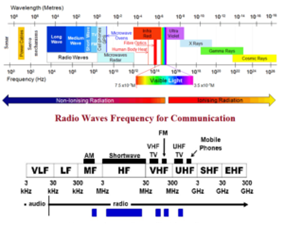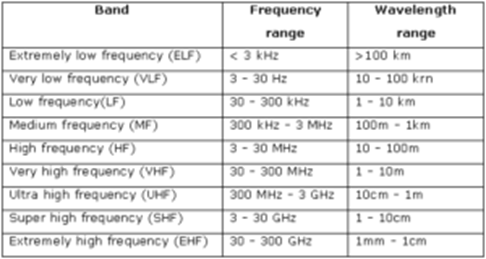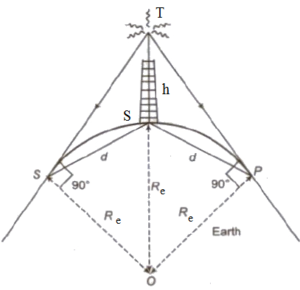Science > Physics > Communication > Communication Channel: Atmosphere
A communication channel is a link connecting a transmitter and a receiver. It is the physical medium which carries the signal from the transmitter to the receiver ideally without any noise or distortion. The atmosphere, optical fibres, parallel wires, coaxial cables, etc. are used as communication channels. In this article, we shall study communication wave propagation in the system.
There are two types of communication a) space communication and b) line communication.
- Space Communication: In this method, the signal is freely transmitted in space using transmitter antenna and it is received by intercepting the signal with the help of a receiver antenna. This is a non-directional form of communication.
- Line Communication: In this method, a signal is guided along conducting a physical path like cables or optical fibre (a line) to the receiver. This is directed communication.
Earth’s Atmosphere:
Earth is surrounded by an envelope of gases called the atmosphere. It extends to about 400 km above the surface of the earth. Its composition is not the same everywhere. The atmosphere plays an important role in the transmission of electromagnetic waves. The earth’s atmosphere is broadly divided into four different layers.
Troposphere:
The layer of the atmosphere extending up to a height of 12 km from the surface of the earth is called the troposphere. This layer mostly contains water vapour which leads to the formation of clouds. The local weather changes in the earth’s atmosphere occur in this layer. The density of air at the surface of the earth is about 1.29 kg/m3 it decreases gradually and at the top of the troposphere, it is about 0.129 kg/m3. The temperature falls from about 15 °C to – 50 °C
Stratosphere:
The region of the earth’s atmosphere lying between 12 km to 50 km is called the stratosphere. The ozone layer is part of the stratosphere extending from 15 km to 30 km; which absorbs the harmful ultraviolet radiations from the sun. Ultraviolet rays are very harmful to living cells. The density of air at the bottom of stratosphere 1.29 kg/m3, it decreases gradually and at the top of the stratosphere, it is about 1.29 x 10-3 kg/m3. The temperature increases from – 50 °C to 10 °C.
Mesosphere:
The region of the earth’s atmosphere lying between 50 km to 80 km is called the mesosphere. The density of air at the bottom of mesosphere 1.29 x 10-3 kg/m3, it decreases gradually and at the top of the mesosphere, it is about 1.29 x 10-5 kg/m3. The temperature falls from 10 °C to – 90 °C.
Ionosphere:
The outermost layer of the earth’s atmosphere is called the ionosphere extending from 80 km to 400 km. The Ionosphere contains charged particles and plays an important role in space communication. The density of air at the bottom of ionosphere 1.29 x 10-5 kg/m3, it decreases gradually and at the top of the ionosphere, it is about 1.29 x 10-10 kg/m3. The temperature rises from -90 °C to 400 °C to a height of 110 km from the surface of the earth. This region is called thermosphere.
The ultraviolet rays and x-rays coming from sun ionize the gases in the upper layer to produce electrons and positive ions. The ionosphere is not uniform due to the varying composition of the atmosphere at different heights. The free electron density is found to be very high in a layer between 100 km to 125 km from the surface of the earth. This layer is called E-layer or Kennelly Heaviside layer. Instead of attenuating radio communications signals this layer chiefly refracts them, often to a degree where they are returned to earth. As such they appear to have been reflected by this layer.
Beyond E-layer up to 250 km the electron density decreases considerably. Again from 250 km to 350 km, there is high electron density. This region is known as the Appleton layer or F-layer. This layer is useful for long-distance transmission of high-frequency waves.
Importance of Radio Waves in Communication:

Radio waves are electromagnetic waves of wavelength 10-3m and higher. Their frequency range is from a few kHz to nearly a few hundred MHz. The propagation of radio waves through the atmosphere is relevant in all modern forms of communication like radio, television, microwaves etc. The different bands of radio wave frequencies are as follows

Space Communication:
The process of sending, receiving and processing of information through space without any special communication channel is called space communication. Waves travel in straight lines until the earth and the atmosphere alter their path. HF waves travel in straight (due to a change in density of atmosphere) line except for refraction
The information to be transmitted is superimposed on a high-frequency electromagnetic wave called the carrier wave. After superimposition, the resultant wave called the modulated wave is transmitted from one place to another by using an antenna. The electromagnetic waves emitted by a transmitting antenna can reach the receiver antenna by the following three modes:
A Ground Wave or Surface Wave Propagation:
The electromagnetic waves emitted from the transmitting antenna propagate along the surface of the earth are called ground waves or surface waves and this type of propagation is called ground wave propagation or surface wave propagation. This type of propagation can take place when the transmitting and receiving antenna are close to the surface of the earth.
When a ground wave propagates over the surface of the earth, eddy currents are induced in the surface of the earth which causes attenuation of these waves. Moreover, as they travel over the earth’s surface they bend along the curvature of the earth which results in energy losses. Thus, ground wave propagation is restricted to small distances. The maximum range of coverage depends upon the transmitted power and frequency because the high-frequency waves suffer more absorption of energy in the earth’s atmosphere. Hence it cannot be used for high-frequency TV and frequency modulated (FM) broadcasts.
The ground wave transmission becomes weaker as the frequency of the electromagnetic wave increases hence this mode of transmission is restricted to frequencies below 1500 kHz. Hence it is used in amplitude modulated (AM) medium wave and long-wave radio broadcast and radio navigational support. All broadcast below 1500 kHz radio signals received in daytime propagate by means of the surface wave.
A Skywave Propagation:
The electromagnetic waves emitted by transmitting antenna are received after being reflected from the ionosphere are called sky waves and this type of propagation is called Sky wave Propagation.
The skywave propagation occurs due to the total internal reflection of the electromagnetic waves by the ionosphere. The ionosphere consists of free positive and negative ions produced due to the ionization of atoms and molecules present in the atmosphere. The charged density of the ionosphere increases with height which results in the decrease in its refractive index.
The electromagnets waves having frequencies less than 2 MHz are absorbed by the ionosphere whereas those having frequencies greater than 30 MHz pass through it. Hence the waves with a frequency range from 2 MHz to 30 MHz can be propagated by this method.
Waves in HF range and around are beamed at the sky and reflected by the ionosphere layers of the atmosphere and are received as sky waves. For further transmission, they are reflected by ground towards the sky again. Due to these repetitive reflections, the wave travels long distances. For skywave propagation gaseous medium is required. Hence this type of communication is not possible ins space or on the moon due to the absence of the atmosphere.
As the angle of emission of waves from the transmitter with respect to earth’s surface increase, a stage will be reached when the ionosphere layers do not reflect the waves towards the earth but transmit through it.
The maximum frequency at which total internal reflection from ionosphere takes place is called critical frequency. Mathematically critical frequency is given by

Where fc = critical frequency and Nmax = Maximum electron density of the ionosphere
Space Wave Propagation:
The electromagnetic waves emitted by transmitter antenna travel directly from the transmitting antenna to the receiving antenna are called space waves and this type of propagation is called space wave propagation. It is used for line of sight (LOS) communication and satellite communication.
High-frequency electromagnetic waves cannot be transmitted as ground waves due to high energy losses. Moreover, these waves are absorbed by the ionosphere hence they cannot be transmitted via skywave propagation. Therefore, such high-frequency electromagnetic waves are directly transmitted throng Earth atmosphere using a transmitting antenna As these waves travel in a straight line, the receiving antenna must be in the line of sight of the transmitting antenna.
This method is used for transmission of waves in very high frequency (VHF) band, the ultra-high-frequency band (UHF), microwaves, etc. The TV signals having frequency band 54-806 MHz can propagate neither via ground waves (due to high absorption in the atmosphere) nor via sky waves (due to non-reflection of the ionosphere). Hence TV signals can only be propagated through space wave only.
Previous Topic: Terminology of Communication System
Next Topic: Coverage Area of the Antenna

One reply on “Communication Channel: Atmosphere”
I thank you. You make it clear.